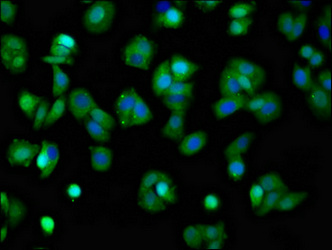KCNQ3 Antibody
-
货号:CSB-PA012091LA01HU
-
规格:¥440
-
促销:
-
图片:
-
Western Blot
Positive WB detected in: SH-SY5Y whole cell lysate, K562 whole cell lysate
All lanes: KCNQ3 antibody at 3μg/ml
Secondary
Goat polyclonal to rabbit IgG at 1/50000 dilution
Predicted band size: 97, 85 kDa
Observed band size: 97 kDa -
Immunofluorescence staining of HepG2 cells with CSB-PA012091LA01HU at 1:100, counter-stained with DAPI. The cells were fixed in 4% formaldehyde, permeabilized using 0.2% Triton X-100 and blocked in 10% normal Goat Serum. The cells were then incubated with the antibody overnight at 4°C. The secondary antibody was Alexa Fluor 488-congugated AffiniPure Goat Anti-Rabbit IgG(H+L).
-
-
其他:
产品详情
-
产品名称:Rabbit anti-Homo sapiens (Human) KCNQ3 Polyclonal antibody
-
Uniprot No.:O43525
-
基因名:KCNQ3
-
别名:BFNC 2 antibody; BFNC antibody; BFNC2 antibody; EBN 2 antibody; EBN2 antibody; KCNQ 3 antibody; KCNQ3 antibody; KCNQ3_HUMAN antibody; KQT like 3 antibody; KQT-like 3 antibody; KV7.3 antibody; Potassium channel subunit alpha KvLQT3 antibody; Potassium channel voltage gated subfamily Q member 3 antibody; Potassium voltage gated channel KQT like protein 3 antibody; Potassium voltage gated channel KQT like subfamily member 3 antibody; Potassium voltage gated channel subfamily KQT member 3 antibody; Potassium voltage-gated channel subfamily KQT member 3 antibody; Voltage gated potassium channel subunit Kv7.3 antibody; Voltage-gated potassium channel subunit Kv7.3 antibody
-
宿主:Rabbit
-
反应种属:Human
-
免疫原:Recombinant Human Potassium voltage-gated channel subfamily KQT member 3 protein (763-872AA)
-
免疫原种属:Homo sapiens (Human)
-
标记方式:Non-conjugated
本页面中的产品,KCNQ3 Antibody (CSB-PA012091LA01HU),的标记方式是Non-conjugated。对于KCNQ3 Antibody,我们还提供其他标记。见下表:
-
克隆类型:Polyclonal
-
抗体亚型:IgG
-
纯化方式:>95%, Protein G purified
-
浓度:It differs from different batches. Please contact us to confirm it.
-
保存缓冲液:Preservative: 0.03% Proclin 300
Constituents: 50% Glycerol, 0.01M PBS, pH 7.4 -
产品提供形式:Liquid
-
应用范围:ELISA, WB, IF
-
推荐稀释比:
Application Recommended Dilution WB 1:500-1:5000 IF 1:50-1:200 -
Protocols:
-
储存条件:Upon receipt, store at -20°C or -80°C. Avoid repeated freeze.
-
货期:Basically, we can dispatch the products out in 1-3 working days after receiving your orders. Delivery time maybe differs from different purchasing way or location, please kindly consult your local distributors for specific delivery time.
相关产品
靶点详情
-
功能:Associates with KCNQ2 or KCNQ5 to form a potassium channel with essentially identical properties to the channel underlying the native M-current, a slowly activating and deactivating potassium conductance which plays a critical role in determining the subthreshold electrical excitability of neurons as well as the responsiveness to synaptic inputs. Therefore, it is important in the regulation of neuronal excitability.
-
基因功能参考文献:
- Phylogenetic analysis, electrostatic potential mapping, in silico docking, electrophysiology, and radioligand binding assays reveal that the anticonvulsant binding pocket evolved to accommodate endogenous neurotransmitters including gamma-aminobutyric acid, which directly activates KCNQ5 and KCNQ3 via W265. PMID: 29748663
- Tannic acid activates Kv7.4 and Kv7.3/7.5 K(+) channels resulting in vasodilation. PMID: 26969140
- Carboxyl terminus helix C-D linker residues play a role in KCNQ3 current amplitudes by controlling the exit of the KCNQ3 channel from the endoplasmic reticulum. PMID: 26692086
- In bipolar disorder patients' prefrontal cortex, Kcnq3 expression was decreased, DNA methylation was decreased, and Kcnq3 mRNA was decreased compared to controls. PMID: 25041603
- the clinical and EEG features of this patient further on expand the phenotypic variability of KCNQ3 gene mutations PMID: 25278462
- mutations in KCNQ3, similarly to KCNQ2, can be found in patients with more severe phenotypes including intellectual disability PMID: 25524373
- We monitored KCNQ2/3 channel currents and translocation of PHPLCdelta1 domains as real-time indicators of PM PI(4,5)P2, and translocation of PHOSH2x2, and PHOSH1 domains as indicators of plasma membrane and Golgi PI(4)P, respectively. PMID: 24843134
- This study demonistrated that benign neonatal sleep myoclonus can show autosomal dominant inheritance but not allelic to KCNQ3. PMID: 22447848
- KCNQ3 mutations might be involved in families with infantile seizures. PMID: 23360469
- Data show that KCNQ3 and KCNE5 mRNA expressions were significantly upregulated in preeclampsia. PMID: 21730298
- Different structural determinants, identified at the N and C termini of KCNQ3, prevent the effects of syntaxin 1A and calmodulin, respectively. PMID: 21976501
- This study reported that the presence of this uncommon residue at position 315 has a strong impact on the stability of the homotetramers and on channel trafficking. PMID: 20610766
- There may be a genetic contribution of this gene in juvenile myoclonic epilepsy in a South Indian population. PMID: 12928862
- Several BFNC mutations of KCNQ2 and KCNQ3 disrupt surface expression or polarized surface distribution of KCNQ channels, thereby revealing impaired targeting of KCNQ channels to axonal surfaces as a benign familial neonatal convulsions (BFNC) etiology. PMID: 16735477
- ICA-27243 is a novel and selective KCNQ3 potassium channel activator. PMID: 18089837
- The expression of KCNQ3 increased in late fetal life to infancy in brain. PMID: 18166285
- This study identified a novel missense mutation of KCNQ3, c.988C>T located within exon 6. c.988C>T led to the substitution Cys for Arg in amino acid position 330 (p.R330C) in KCNQ3 potassium channel. PMID: 18249525
- A three-dimensional homology model in the W309R mutant indicated that the R side chain of pore helices is too far from the Y side chain of the selectivity filter to interact via hydrogen bonds with each other and stabilize the pore structure. PMID: 18425618
- Sequence variations of the KCNQ2 (and KCNQ3)genes may contribute to the etiology of common idiopathic epilepsy syndromes. PMID: 18625963
- among the allowed assembly conformations are KCNQ3/4 and KCNQ4/5 heteromers. PMID: 18786918
- most wild-type channels are functionally silent, with rearrangements of the pore-loop architecture induced by the presence of a hydroxyl-containing residue at the 315 position "unlocking" the channels into a conductive conformation PMID: 18790849
显示更多
收起更多
-
相关疾病:Seizures, benign familial neonatal 2 (BFNS2)
-
亚细胞定位:Cell membrane; Multi-pass membrane protein.
-
蛋白家族:Potassium channel family, KQT (TC 1.A.1.15) subfamily, Kv7.3/KCNQ3 sub-subfamily
-
组织特异性:Predominantly expressed in brain.
-
数据库链接:
HGNC: 6297
OMIM: 121201
KEGG: hsa:3786
STRING: 9606.ENSP00000373648
UniGene: Hs.374023
Most popular with customers
-
-
Phospho-YAP1 (S127) Recombinant Monoclonal Antibody
Applications: ELISA, WB, IHC
Species Reactivity: Human
-
-
-
-
-
-























